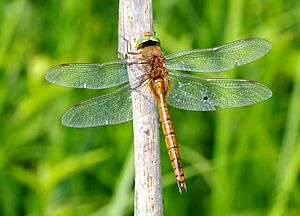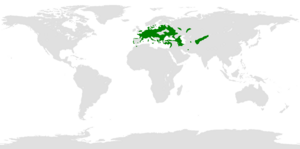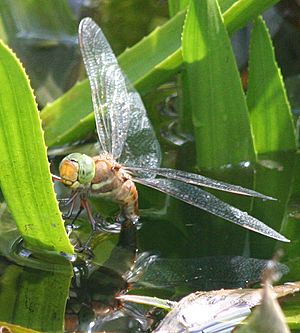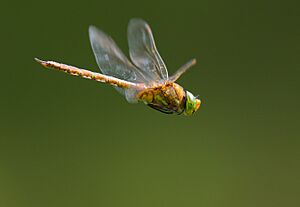Green-eyed hawker facts for kids
Quick facts for kids Green-eyed hawker |
|
|---|---|
 |
|
| Conservation status | |
| Scientific classification | |
 |
|
| Range of Aeshna isoceles |
The Green-eyed hawker (Aeshna isoceles) is a type of dragonfly. It's a small hawker dragonfly found mostly in Europe, especially around the Mediterranean Sea, and in the lowlands of North Africa. In Britain, it's quite rare and is known as the Norfolk hawker. This dragonfly has a brown body, bright green eyes, and clear wings. It also has a special yellow triangle mark on its second body segment, which helps identify it. Its scientific name, isoceles, comes from this triangle shape.
Contents
How to Spot a Green-eyed Hawker
The Green-eyed hawker is one of only two brown hawker dragonflies in Europe. The other is A. grandis. Both have brown bodies. However, the Green-eyed hawker has bright green eyes and clear wings. It also has a clear yellow triangle on its second abdominal segment. Its hindwings have a small amber patch near their base.
In contrast, A. grandis has yellowish wings and bluish eyes. The bright green eyes of the Green-eyed hawker are easy to see, even when it's flying. This makes it simple to tell these two dragonflies apart. Also, the Green-eyed hawker flies much earlier in the year than A. grandis.
Where Green-eyed Hawkers Live
The Green-eyed hawker is found in central Europe and around the Mediterranean Sea. It also lives in the lowlands of North Africa. It is more common in eastern Europe than in southwestern Europe. For example, it lives in Spain and Portugal, but it is not found everywhere there.
These dragonflies like wet areas. They can be found near ponds, ditches, and marshes. They prefer places with lots of plants. In England, studies showed they often live where Water-soldier plants (Stratiotes aloides) grow.
Status in Britain
The Norfolk hawker has always been a rare insect in Britain. It used to be found in the Cambridgeshire fens. However, by the early 1980s, its numbers had dropped a lot. Now, it mainly lives in clean fens and marshes. These areas are found in the Broadlands of Norfolk and north-east Suffolk.
You can find them in places like Hickling Broad. They also live in two national nature reserves: Mid-Yare NNR and Ludham - Potter Heigham NNR. Another spot is Castle Marshes in the Barnby Broad and Marshes SSSI. Since 2011, this species has also been seen in the Stour valley in east Kent. They seem to be spreading there. The Norfolk hawker is a protected species in Britain. It is listed as endangered in British Red Data Books on Insects.
Behaviour and Life Cycle
The Green-eyed hawker is one of the first Aeshna dragonflies to fly each year. They are usually seen from May to August. Adult Green-eyed hawkers do not fly as much as other Aeshna dragonflies.
Male dragonflies fly over water to protect their territory. If a pond is small, the male will hover right over its center. Unlike other Aeshna species that fly almost constantly, male Green-eyed hawkers will often rest on plants.
Females lay their eggs (this is called ovipositing) onto plants. The eggs hatch in about two weeks. The young dragonflies, called larvae, then live in the water. It takes them about two years to grow and develop before they become adult dragonflies.
Scientific Name
The scientific name of this dragonfly is Aeshna isoceles. It was first described by Muller in 1764. Over time, it has been known by a few different names. You might see it called Anaciaeschna isoceles in some older books. However, today, most scientists call it Aeshna isoceles. The original specific name was actually spelled isosceles.




